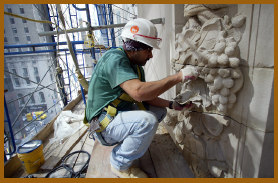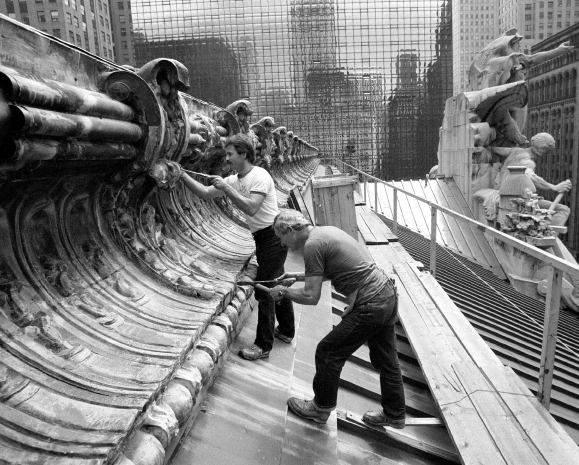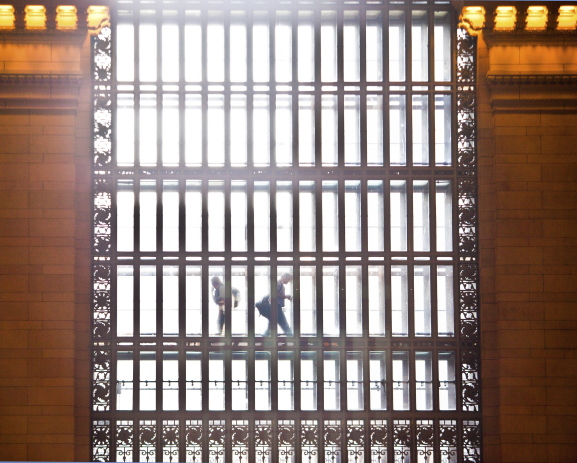

JUSTICE IRVING SAYPOL’S DECISION to void the landmarks designation of Grand Central Terminal could not have come at a better time. “The station is probably in no immediate danger,” the New Yorker noted imperturbably. “Who’s going to start putting up another office building this year?”
In 1975, when Saypol issued his decision, New York City was teetering on the brink of municipal bankruptcy. Public works projects were halted midway, leaving the steel skeletons of new schools to rust. Another landmark—the elegant but disintegrating Tweed Courthouse behind City Hall, which was to be razed and replaced with a parking lot—was spared only because the city could no longer afford to tear it down. Private developers also packed away blueprints and placed planned construction on hold. (William Wilgus’s original plans for a tower over the terminal might have been scrapped because of similar economic qualms on the eve of World War I; he wrote later only that they “fell by the wayside.”)

KODAK’S MAMMOTH 18-BY-60-FOOT COLORAMA, A 15-FOOT MUTANT VERSION OF WESTCLOX’S BIG BEN ALARM CLOCK, AND A MERRILL LYNCH BOOTH DOMINATED THE CONCOURSE.
Three years later, when the Supreme Court saved Grand Central, precisely what had been saved since the landmarking process began must have provided grist for some serious second thoughts. By then, the interior of the terminal had been festooned with advertising and even a Merrill Lynch, Pierce, Fenner & Smith investment booth in the Main Concourse; the giant baleful clock, which by now was advertising Manufacturers Hanover; and a Chemical Bank branch, perched obtrusively under the Kodak sign. “Right now, this space looks like—like St. Patrick’s lit up for television,” Philip Johnson fretted. “Grand Central has become honky-tonk, with its extra-dimensional advertising displays and its tendency to adopt the tactics of a travel broker,” E.B. White groused, complaining that “the great hall seemed to me one of the more inspiring interiors in New York, until Lastex and Coca-Cola got into the temple.” Paul Goldberger, then the Times’ architecture critic, agreed, arguing that the concourse should serve as “a discreet background for human movement, not a room with movement of its own.”
MEANWHILE, THE GRAND CENTRAL PALACE on Lexington Avenue between 46th and 47th Streets, the city’s premier exhibition hall, was razed for a 47-story office building. The 1,900-room Commodore Hotel, which the Penn Central said was losing more than $1 million a year, abruptly closed in May 1976, throwing its 500 remaining employees out of work. The C and T in the name of the 34-story New York Central Building at 230 Park Avenue, the railroad’s sublime and historic gem of a headquarters since 1929, were ignominiously chiseled into a G and an E when the building was sold to General Tire & Rubber (a ninth-floor office in 230 Park had been the scene of the mob execution of Mafia boss Salvatore Maranzano in 1931; appropriately enough, in The Godfather the meeting of the five Mafia families was filmed in the Central’s 32nd-floor boardroom, with its mural of Engine 999; it was also described as Dagny Taggart’s Transcontinental Railroad Building in Ayn Rand’s Atlas Shrugged and later became the Helmsley Building).
Since the Penn Central had gone belly up in 1970, operation of the terminal was turned over to Conrail (and, in 1983, to the Metropolitan Transportation Authority’s Metro-North). In still another retrenchment, the railroad recommended the cancellation of all nine predawn passenger trains (only a decade before, there were 30), sending musicians, bartenders, printers, and other graveyard-shift workers scurrying to find alternative routes home. In 1973, for the first time in its modern history, Grand Central was shuttered every night from 1:30 to 5:30 a.m., ostensibly to facilitate cleaning, but also to recapture the terminal from the growing proliferation of homeless people and other “undesirables” who congregated in its public spaces and encamped in the train yards beneath it.
Vanderbilt Avenue had become a haven for drug dealing, and surging crime seemed even more dangerous on dim and claustrophobic passageways and platforms. In 1977, the landing gear collapsed on a helicopter that had just alighted atop the Pan Am Building, killing six people, including a pedestrian below, who was struck by one of the copter’s 20-foot blades. The accident doomed regular copter service from the roof.
STILL, A COCKEYED OPTIMIST could point to a few hopeful signs for the deteriorating terminal and its beleaguered neighborhood. By 1978, Philip Morris was eying the southwest corner of Park and 42nd Street for a sleek corporate headquarters. (Its building, three-and-a-half stories higher after the company acquired 75,000 square feet of air rights from Grand Central, would help doom the classic image of the Main Concourse bathed in shafts of sunlight streaming from most of its southern lunette windows.) The railroad had profitably sold off the Barclay, Biltmore, and Roosevelt hotels. Penn Central also dumped the adjacent Commodore Hotel in a complex deal involving tax breaks, leasebacks, and other investment arcana among the city, the state Urban Development Corporation, Donald Trump, and the Hyatt Hotel Corporation. In addition to restoring the hotel inside and out, the deal was intended to generate $2 million to clean Grand Central’s exterior. “As an investment,” Ada Louis Huxtable wrote presciently, “this could well be seed money for far greater returns in the start of a revitalized 42nd Street.”
Something else had changed too. The city was slowly rebounding from the depths of a demoralizing fiscal crisis, and a new mayor, Edward I. Koch, was leading the charge as cheerleader in chief. (When asked in 1975 whether the demolition of Grand Central was inevitable if it could not support itself, Koch replied characteristically: “Central Park doesn’t support itself. God forbid we should ever think of it in that way.”) If New York still could not afford to build grand new projects, it could at least muster the will to salvage its Gilded Age gems. Year later in the New Yorker, Tony Hiss explained it another way:
While many of the links that connect places and experiences and health have yet to be traced, some people have started treating their own experiences of places in a mid-19th century-clean-water fashion, by taking action to protect experiences that are important to them—for example, fighting the demolition of places like Grand Central Terminal… The people involved in this work speak, often, not just of architectural beauty but of the character of a place, or its essential spirit, or the quality of life there, or of its livability, genius, flavor, feeling, ambience, essence, resonance, presence, aura, harmony, grace, charm or seemliness. These are probably allusions to an actual direct experience of some place.
The architect Philip Johnson noticed the change that Jacqueline Onassis and other prominent champions of Grand Central had wrought. “When they tore down Pennsylvania Station, there were just six of us trying to save it,” he recalled. “We stood outside the station as people went in and out, and they all wanted to know if we were kooks or what. We told them we were trying to save the station. ‘What station?’ they said. That won’t happen this time.”
BY THE TERMINAL’S 75TH BIRTHDAY, IN 1988, the Brobdingnagian advertising timepiece (billed as the world’s largest indoor clock), second as a target for architectural purists only to the Kodak sign, had been removed. “In any other place the Kodak Colorama sign in Grand Central Terminal would be a preservation issue,” Christopher Gray of the Times acknowledged. But, he concluded, the sign, which greeted millions of passengers with pastoral farm scenes and Alpine idylls, was, like the proposed skyscraper atop the terminal, simply in the wrong place at the wrong time. Kodak was paying a hefty $450,000 a year to promote itself, but Metro-North, signaling an enduring and—for a government agency—unusual commitment to enlightened self-interest, refused to grant a long-term lease. The sign was removed early in 1990.
Still, pessimists, too, had ample grounds to dismiss Grand Central’s physical condition as, well, terminal—it was like that of an aging convict suffering from an incurable disease but given a reprieve from execution. The punch list for the building’s neglected interior was miles long.
“Grand Central had been spared the wrecking ball, but was far from saved,” according to the MTA’s own official history of the terminal. “After decades of deferred maintenance, the building was crumbling. The roof leaked; stonework was being chipped away; structural steel was rusting. Pollution and dirt had stained surfaces. Commercial intrusions blocked out natural light.”

SINCE 1983, THE MTA HAS INVESTED OR COMMITTED NEARLY $1 BILLION TO MAINTAIN AND IMPROVE THE TERMINAL.
Early in 1982, offices and the stairway to the 43rd Street exit were closed because of leaks and cascading plaster, apparently caused by the gut renovation of the Biltmore Hotel across Vanderbilt Avenue. A month later, commuters dodged falling plaster and dripping water, which forced officials to close a waiting room and the terminal’s sole locker room. When Metro-North was created in 1983, among its first priorities were the copper roof and the porous deck over Park Avenue. “By sealing the roof first and stopping the water from coming in,” said Wayne Ehmann, the railroad’s chief architect, “we can then start tackling interior problems.”

WHEN THE MTA TOOK OVER FROM CONRAIL, THE FIRST PRIORITY WAS THE ROOF, WHICH JIMMY CERMINARO AND HUGO NACCARATO REPAIRED IN 1987.
Fixing the roof was not your average $4.5 million home repair job. The roof suffered not only from decades of neglect, but also from a basic misunderstanding about metal fatigue. Particularly at its fringes, the plates were frayed and fractured by repeated expansion and contraction caused by changing temperatures. The 55,000 square feet of copper had to be replaced by eight-foot-long panels nailed to wooden strips 20 inches apart. The six-foot-high frieze needed repairs. Eight 24-foot-square skylights blacked out during World War II had to be scraped of peeled paint or have new panes installed. Only then could preservationists, architects, and engineers tackle the interior.

GLASS CATWALKS SANDWICHED BETWEEN THE DOUBLE-PANED WINDOWS OFTEN SILHOUETTE OFFICE WORKERS. THE DESIGN PROVIDED LIGHT, VENTILATION, AND ACCESS TO OFFICES.
IF JACQUELINE ONASSIS DESERVES CREDIT for saving Grand Central from rapacious developers and shortsighted railroad managers, Peter E. Stangl, the president of Metro-North in the 1980s, saved the terminal from itself. Stangl, a former college economics teacher from Connecticut who once quit a high-level job to hustle pool for nearly a year, became the first president of the Metro-North Commuter Railroad in 1983 (under MTA Chairman Richard Ravitch) when it was created by New York and Connecticut from the cadaverous remains of Conrail’s bankrupt metropolitan passenger service. Three years earlier, on September 23, 1980, the city landmarks commission extended its protection of Grand Central to the interior spaces after a pro forma hearing in which one witness spoke in favor and no speaker bothered to dissent (although a tenant, the Metropolitan Transportation Authority, reluctant to be constrained, expressed reservations in writing).
When the terminal turned 75 in 1988, Stangl outlined three goals: “First and foremost, we want Grand Central to be a terrific train station again. Secondly, it’s important to restore the building’s architectural integrity. And thirdly, we want to improve the way we use space for retail purposes.” Eight years later, Stangl was named chairman of the Metropolitan Transportation Authority by Governor Mario M. Cuomo. It was Stangl—who commuted daily from a 1792 farmhouse in Chappaqua—who insisted that no legitimate expense be spared in salvaging the aging terminal and transforming it into a shrine to what government at its most enlightened can accomplish. His reverence for Grand Central bordered on the divine. “Some mornings you’ll see light flooding into the terminal,” he said. “It’s almost religious.”
And if there was one person on whom Stangl depended (beside Frederick Harris and Susan Fine, directors of the MTA’s real estate department), whose counsel he sought and whose vision he embraced, it was John Belle, a Welsh immigrant, whose firm, Beyer Blinder Belle, would be tapped to restore the Ellis Island Immigration Museum and was recruited in the late 1980s to supervise the restoration of Grand Central and develop a master plan.
“Grand Central is magnificent architecture, but it is brilliant urbanism, an object lesson in the integration of a monumental work of architecture into the larger urban fabric of buildings, streets, viaducts and ramps,” the architecture critic Paul Goldberger wrote in the Times in 1990. “The genius of the original architects was to create a noble building that did not stand aloof, but was a superbly functioning part of everyday life in New York, and the master plan recognizes this and enhances it.”